Analysis of Intellectual Property Law: Cadbury, Nestlé, and Glaxo
VerifiedAdded on 2022/12/30
|9
|2453
|76
Report
AI Summary
This report critically analyzes the reasoning behind the refusal of Cadbury's application to register the color purple as a trademark, referencing the earlier decision in Libertel Groep BV v Benelux-Merkenbureau. It examines the key arguments presented by Nestlé and the court's judgment, focusing on the distinctiveness and graphical representation of the color mark. Furthermore, the report evaluates the later developments in intellectual property law, specifically in the case of Glaxo Wellcome UK Ltd & Anor v Sandoz Ltd & Ors, which involved a claim of passing off related to the color of pharmaceutical inhalers. The analysis explores the court's guidelines on misrepresentation and the importance of consumer awareness in determining trademark infringement. The report concludes by summarizing the key principles of intellectual property law, particularly regarding trademarks and the protection of creative works, emphasizing the significance of distinctiveness and graphical representation in trademark registration, as highlighted by both Cadbury and Glaxo cases.
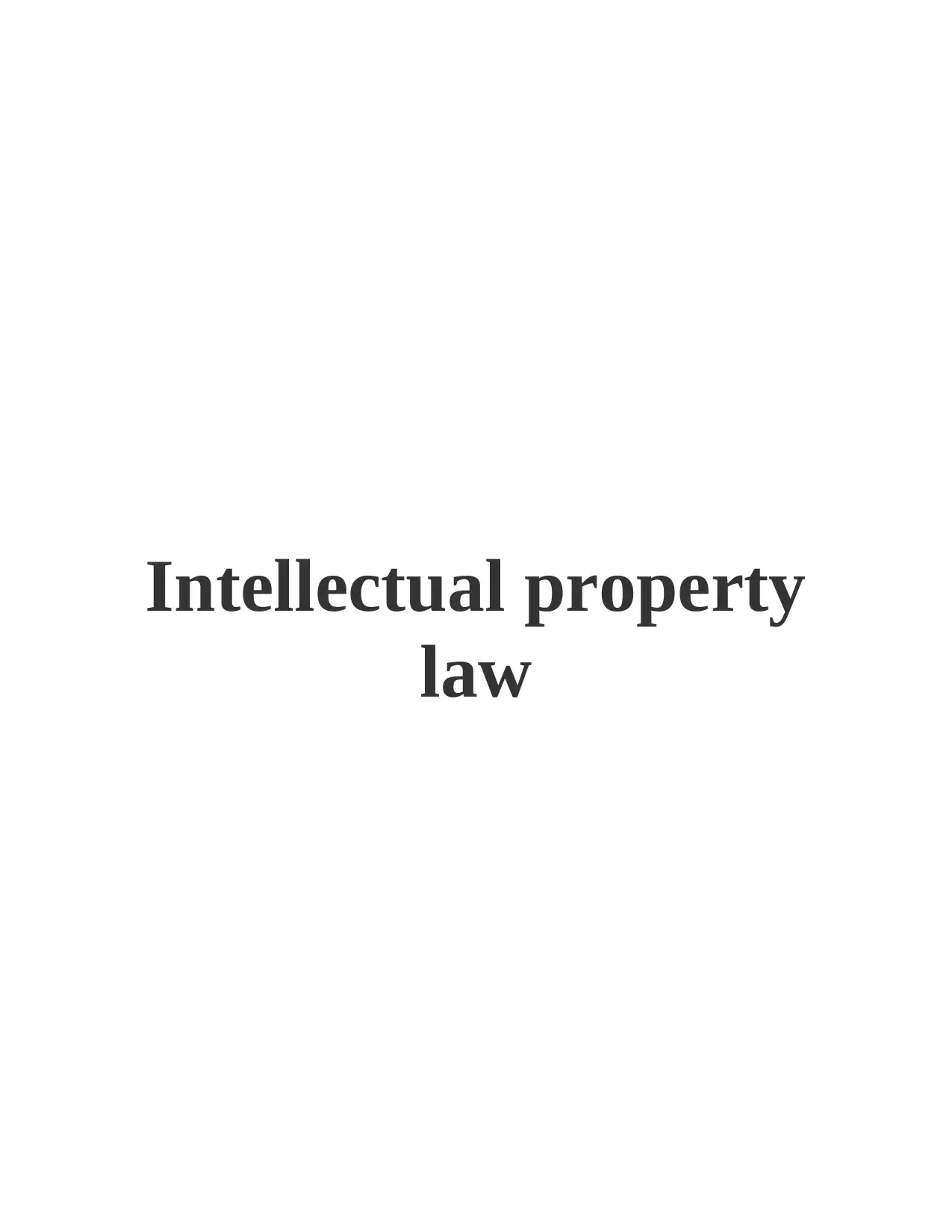
Intellectual property
law
law
Paraphrase This Document
Need a fresh take? Get an instant paraphrase of this document with our AI Paraphraser
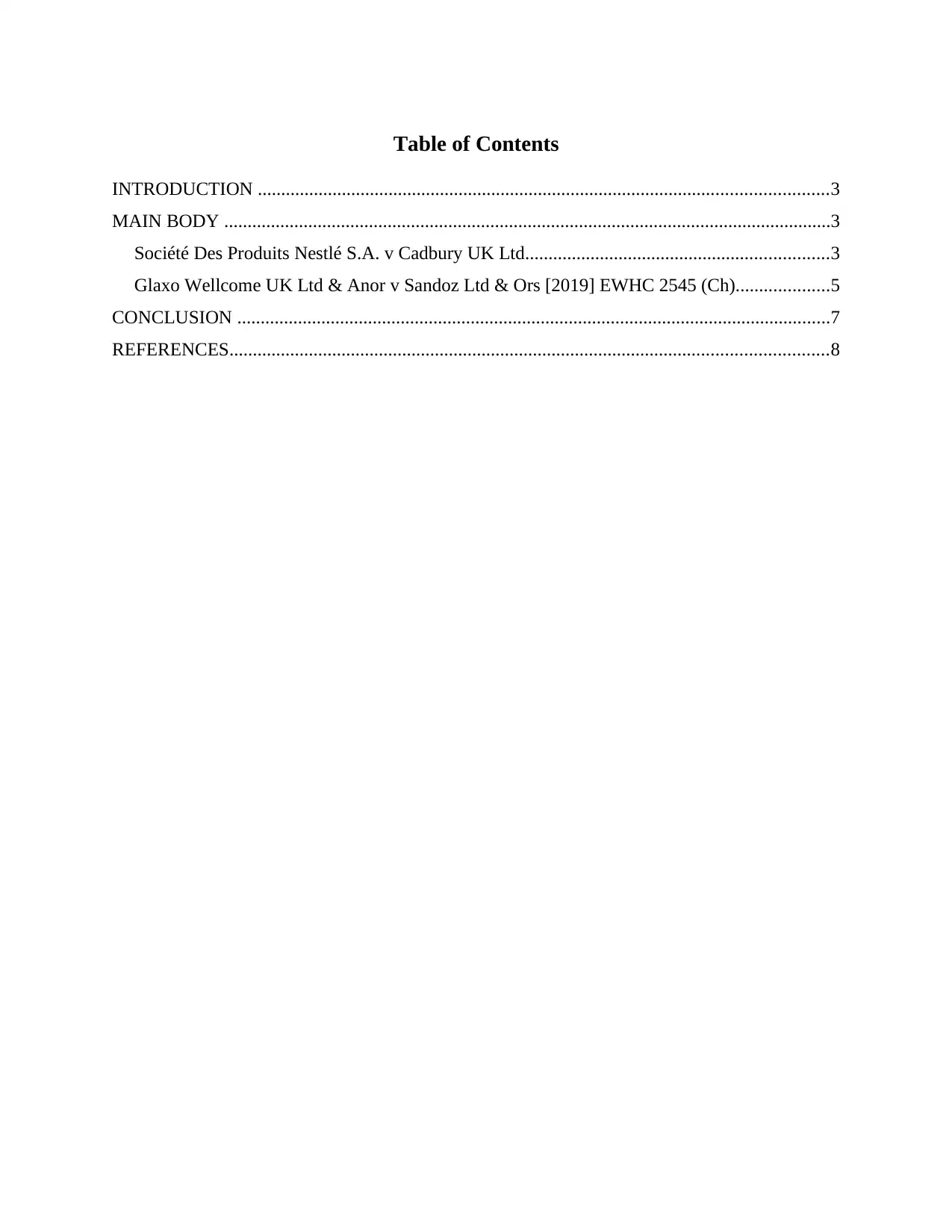
Table of Contents
INTRODUCTION ..........................................................................................................................3
MAIN BODY ..................................................................................................................................3
Société Des Produits Nestlé S.A. v Cadbury UK Ltd.................................................................3
Glaxo Wellcome UK Ltd & Anor v Sandoz Ltd & Ors [2019] EWHC 2545 (Ch)....................5
CONCLUSION ...............................................................................................................................7
REFERENCES................................................................................................................................8
INTRODUCTION ..........................................................................................................................3
MAIN BODY ..................................................................................................................................3
Société Des Produits Nestlé S.A. v Cadbury UK Ltd.................................................................3
Glaxo Wellcome UK Ltd & Anor v Sandoz Ltd & Ors [2019] EWHC 2545 (Ch)....................5
CONCLUSION ...............................................................................................................................7
REFERENCES................................................................................................................................8
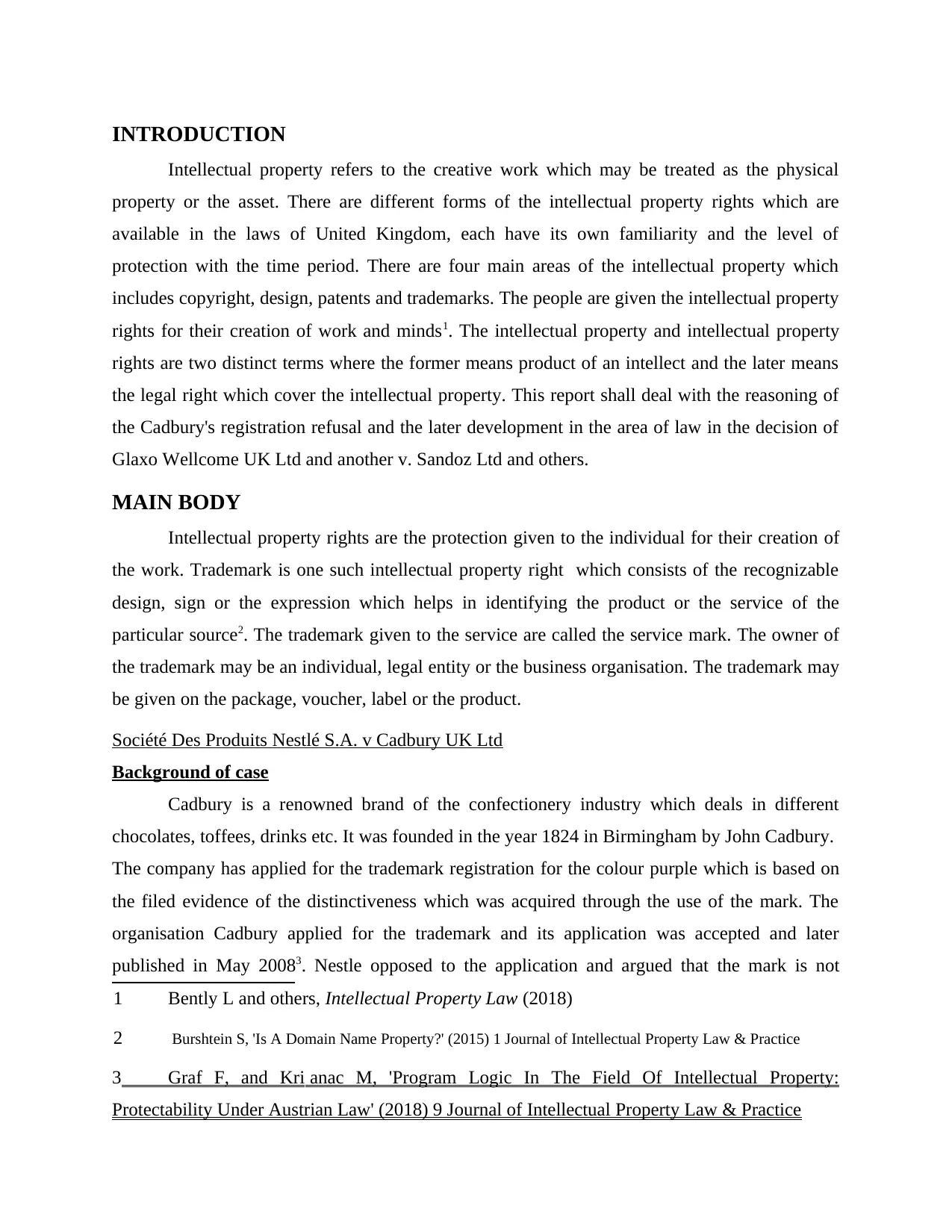
INTRODUCTION
Intellectual property refers to the creative work which may be treated as the physical
property or the asset. There are different forms of the intellectual property rights which are
available in the laws of United Kingdom, each have its own familiarity and the level of
protection with the time period. There are four main areas of the intellectual property which
includes copyright, design, patents and trademarks. The people are given the intellectual property
rights for their creation of work and minds1. The intellectual property and intellectual property
rights are two distinct terms where the former means product of an intellect and the later means
the legal right which cover the intellectual property. This report shall deal with the reasoning of
the Cadbury's registration refusal and the later development in the area of law in the decision of
Glaxo Wellcome UK Ltd and another v. Sandoz Ltd and others.
MAIN BODY
Intellectual property rights are the protection given to the individual for their creation of
the work. Trademark is one such intellectual property right which consists of the recognizable
design, sign or the expression which helps in identifying the product or the service of the
particular source2. The trademark given to the service are called the service mark. The owner of
the trademark may be an individual, legal entity or the business organisation. The trademark may
be given on the package, voucher, label or the product.
Société Des Produits Nestlé S.A. v Cadbury UK Ltd
Background of case
Cadbury is a renowned brand of the confectionery industry which deals in different
chocolates, toffees, drinks etc. It was founded in the year 1824 in Birmingham by John Cadbury.
The company has applied for the trademark registration for the colour purple which is based on
the filed evidence of the distinctiveness which was acquired through the use of the mark. The
organisation Cadbury applied for the trademark and its application was accepted and later
published in May 20083. Nestle opposed to the application and argued that the mark is not
1 Bently L and others, Intellectual Property Law (2018)
2 Burshtein S, 'Is A Domain Name Property?' (2015) 1 Journal of Intellectual Property Law & Practice
3 Graf F, and Kri anac M, 'Program Logic In The Field Of Intellectual Property:
Protectability Under Austrian Law' (2018) 9 Journal of Intellectual Property Law & Practice
Intellectual property refers to the creative work which may be treated as the physical
property or the asset. There are different forms of the intellectual property rights which are
available in the laws of United Kingdom, each have its own familiarity and the level of
protection with the time period. There are four main areas of the intellectual property which
includes copyright, design, patents and trademarks. The people are given the intellectual property
rights for their creation of work and minds1. The intellectual property and intellectual property
rights are two distinct terms where the former means product of an intellect and the later means
the legal right which cover the intellectual property. This report shall deal with the reasoning of
the Cadbury's registration refusal and the later development in the area of law in the decision of
Glaxo Wellcome UK Ltd and another v. Sandoz Ltd and others.
MAIN BODY
Intellectual property rights are the protection given to the individual for their creation of
the work. Trademark is one such intellectual property right which consists of the recognizable
design, sign or the expression which helps in identifying the product or the service of the
particular source2. The trademark given to the service are called the service mark. The owner of
the trademark may be an individual, legal entity or the business organisation. The trademark may
be given on the package, voucher, label or the product.
Société Des Produits Nestlé S.A. v Cadbury UK Ltd
Background of case
Cadbury is a renowned brand of the confectionery industry which deals in different
chocolates, toffees, drinks etc. It was founded in the year 1824 in Birmingham by John Cadbury.
The company has applied for the trademark registration for the colour purple which is based on
the filed evidence of the distinctiveness which was acquired through the use of the mark. The
organisation Cadbury applied for the trademark and its application was accepted and later
published in May 20083. Nestle opposed to the application and argued that the mark is not
1 Bently L and others, Intellectual Property Law (2018)
2 Burshtein S, 'Is A Domain Name Property?' (2015) 1 Journal of Intellectual Property Law & Practice
3 Graf F, and Kri anac M, 'Program Logic In The Field Of Intellectual Property:
Protectability Under Austrian Law' (2018) 9 Journal of Intellectual Property Law & Practice
⊘ This is a preview!⊘
Do you want full access?
Subscribe today to unlock all pages.

Trusted by 1+ million students worldwide
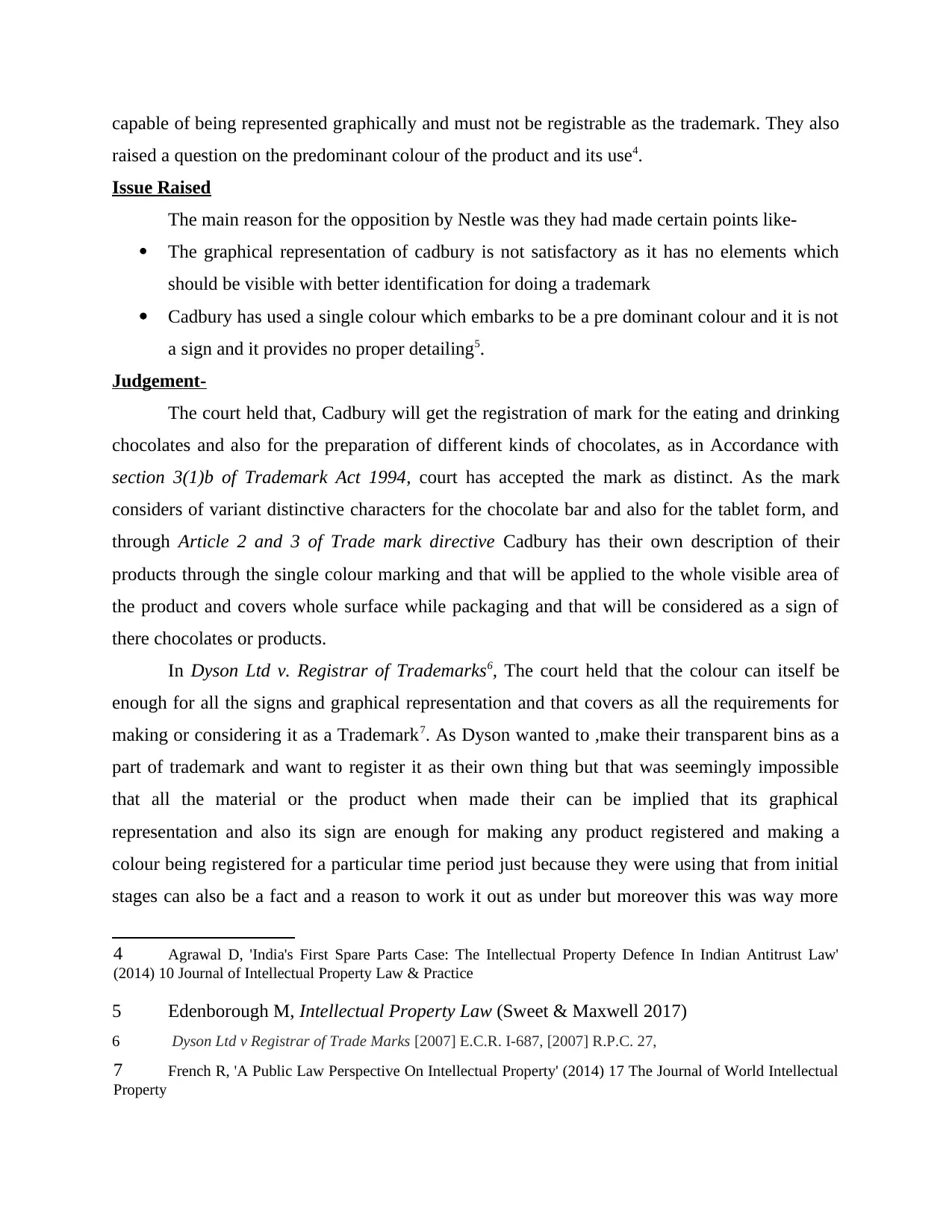
capable of being represented graphically and must not be registrable as the trademark. They also
raised a question on the predominant colour of the product and its use4.
Issue Raised
The main reason for the opposition by Nestle was they had made certain points like-
The graphical representation of cadbury is not satisfactory as it has no elements which
should be visible with better identification for doing a trademark
Cadbury has used a single colour which embarks to be a pre dominant colour and it is not
a sign and it provides no proper detailing5.
Judgement-
The court held that, Cadbury will get the registration of mark for the eating and drinking
chocolates and also for the preparation of different kinds of chocolates, as in Accordance with
section 3(1)b of Trademark Act 1994, court has accepted the mark as distinct. As the mark
considers of variant distinctive characters for the chocolate bar and also for the tablet form, and
through Article 2 and 3 of Trade mark directive Cadbury has their own description of their
products through the single colour marking and that will be applied to the whole visible area of
the product and covers whole surface while packaging and that will be considered as a sign of
there chocolates or products.
In Dyson Ltd v. Registrar of Trademarks6, The court held that the colour can itself be
enough for all the signs and graphical representation and that covers as all the requirements for
making or considering it as a Trademark7. As Dyson wanted to ,make their transparent bins as a
part of trademark and want to register it as their own thing but that was seemingly impossible
that all the material or the product when made their can be implied that its graphical
representation and also its sign are enough for making any product registered and making a
colour being registered for a particular time period just because they were using that from initial
stages can also be a fact and a reason to work it out as under but moreover this was way more
4 Agrawal D, 'India's First Spare Parts Case: The Intellectual Property Defence In Indian Antitrust Law'
(2014) 10 Journal of Intellectual Property Law & Practice
5 Edenborough M, Intellectual Property Law (Sweet & Maxwell 2017)
6 Dyson Ltd v Registrar of Trade Marks [2007] E.C.R. I-687, [2007] R.P.C. 27,
7 French R, 'A Public Law Perspective On Intellectual Property' (2014) 17 The Journal of World Intellectual
Property
raised a question on the predominant colour of the product and its use4.
Issue Raised
The main reason for the opposition by Nestle was they had made certain points like-
The graphical representation of cadbury is not satisfactory as it has no elements which
should be visible with better identification for doing a trademark
Cadbury has used a single colour which embarks to be a pre dominant colour and it is not
a sign and it provides no proper detailing5.
Judgement-
The court held that, Cadbury will get the registration of mark for the eating and drinking
chocolates and also for the preparation of different kinds of chocolates, as in Accordance with
section 3(1)b of Trademark Act 1994, court has accepted the mark as distinct. As the mark
considers of variant distinctive characters for the chocolate bar and also for the tablet form, and
through Article 2 and 3 of Trade mark directive Cadbury has their own description of their
products through the single colour marking and that will be applied to the whole visible area of
the product and covers whole surface while packaging and that will be considered as a sign of
there chocolates or products.
In Dyson Ltd v. Registrar of Trademarks6, The court held that the colour can itself be
enough for all the signs and graphical representation and that covers as all the requirements for
making or considering it as a Trademark7. As Dyson wanted to ,make their transparent bins as a
part of trademark and want to register it as their own thing but that was seemingly impossible
that all the material or the product when made their can be implied that its graphical
representation and also its sign are enough for making any product registered and making a
colour being registered for a particular time period just because they were using that from initial
stages can also be a fact and a reason to work it out as under but moreover this was way more
4 Agrawal D, 'India's First Spare Parts Case: The Intellectual Property Defence In Indian Antitrust Law'
(2014) 10 Journal of Intellectual Property Law & Practice
5 Edenborough M, Intellectual Property Law (Sweet & Maxwell 2017)
6 Dyson Ltd v Registrar of Trade Marks [2007] E.C.R. I-687, [2007] R.P.C. 27,
7 French R, 'A Public Law Perspective On Intellectual Property' (2014) 17 The Journal of World Intellectual
Property
Paraphrase This Document
Need a fresh take? Get an instant paraphrase of this document with our AI Paraphraser
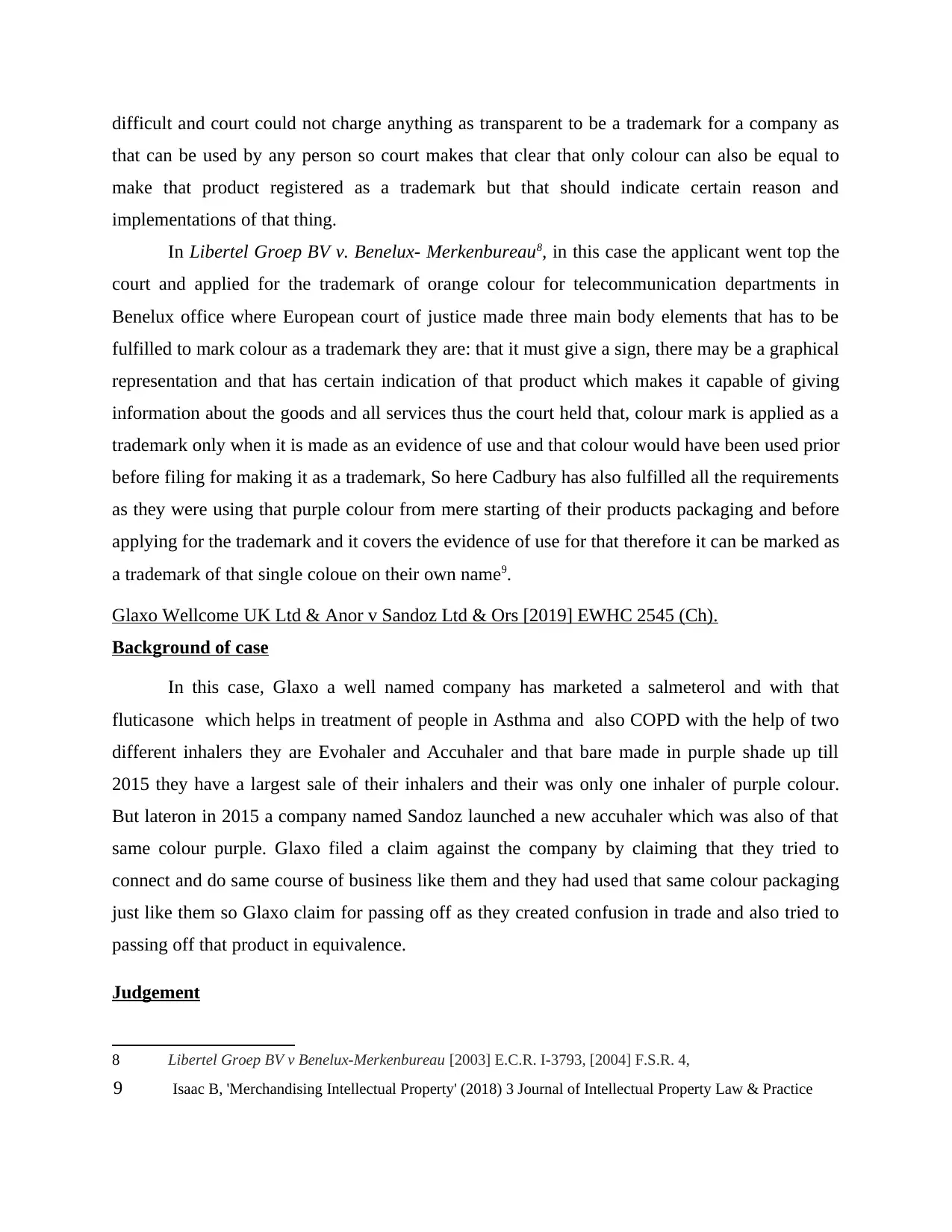
difficult and court could not charge anything as transparent to be a trademark for a company as
that can be used by any person so court makes that clear that only colour can also be equal to
make that product registered as a trademark but that should indicate certain reason and
implementations of that thing.
In Libertel Groep BV v. Benelux- Merkenbureau8, in this case the applicant went top the
court and applied for the trademark of orange colour for telecommunication departments in
Benelux office where European court of justice made three main body elements that has to be
fulfilled to mark colour as a trademark they are: that it must give a sign, there may be a graphical
representation and that has certain indication of that product which makes it capable of giving
information about the goods and all services thus the court held that, colour mark is applied as a
trademark only when it is made as an evidence of use and that colour would have been used prior
before filing for making it as a trademark, So here Cadbury has also fulfilled all the requirements
as they were using that purple colour from mere starting of their products packaging and before
applying for the trademark and it covers the evidence of use for that therefore it can be marked as
a trademark of that single coloue on their own name9.
Glaxo Wellcome UK Ltd & Anor v Sandoz Ltd & Ors [2019] EWHC 2545 (Ch).
Background of case
In this case, Glaxo a well named company has marketed a salmeterol and with that
fluticasone which helps in treatment of people in Asthma and also COPD with the help of two
different inhalers they are Evohaler and Accuhaler and that bare made in purple shade up till
2015 they have a largest sale of their inhalers and their was only one inhaler of purple colour.
But lateron in 2015 a company named Sandoz launched a new accuhaler which was also of that
same colour purple. Glaxo filed a claim against the company by claiming that they tried to
connect and do same course of business like them and they had used that same colour packaging
just like them so Glaxo claim for passing off as they created confusion in trade and also tried to
passing off that product in equivalence.
Judgement
8 Libertel Groep BV v Benelux-Merkenbureau [2003] E.C.R. I-3793, [2004] F.S.R. 4,
9 Isaac B, 'Merchandising Intellectual Property' (2018) 3 Journal of Intellectual Property Law & Practice
that can be used by any person so court makes that clear that only colour can also be equal to
make that product registered as a trademark but that should indicate certain reason and
implementations of that thing.
In Libertel Groep BV v. Benelux- Merkenbureau8, in this case the applicant went top the
court and applied for the trademark of orange colour for telecommunication departments in
Benelux office where European court of justice made three main body elements that has to be
fulfilled to mark colour as a trademark they are: that it must give a sign, there may be a graphical
representation and that has certain indication of that product which makes it capable of giving
information about the goods and all services thus the court held that, colour mark is applied as a
trademark only when it is made as an evidence of use and that colour would have been used prior
before filing for making it as a trademark, So here Cadbury has also fulfilled all the requirements
as they were using that purple colour from mere starting of their products packaging and before
applying for the trademark and it covers the evidence of use for that therefore it can be marked as
a trademark of that single coloue on their own name9.
Glaxo Wellcome UK Ltd & Anor v Sandoz Ltd & Ors [2019] EWHC 2545 (Ch).
Background of case
In this case, Glaxo a well named company has marketed a salmeterol and with that
fluticasone which helps in treatment of people in Asthma and also COPD with the help of two
different inhalers they are Evohaler and Accuhaler and that bare made in purple shade up till
2015 they have a largest sale of their inhalers and their was only one inhaler of purple colour.
But lateron in 2015 a company named Sandoz launched a new accuhaler which was also of that
same colour purple. Glaxo filed a claim against the company by claiming that they tried to
connect and do same course of business like them and they had used that same colour packaging
just like them so Glaxo claim for passing off as they created confusion in trade and also tried to
passing off that product in equivalence.
Judgement
8 Libertel Groep BV v Benelux-Merkenbureau [2003] E.C.R. I-3793, [2004] F.S.R. 4,
9 Isaac B, 'Merchandising Intellectual Property' (2018) 3 Journal of Intellectual Property Law & Practice
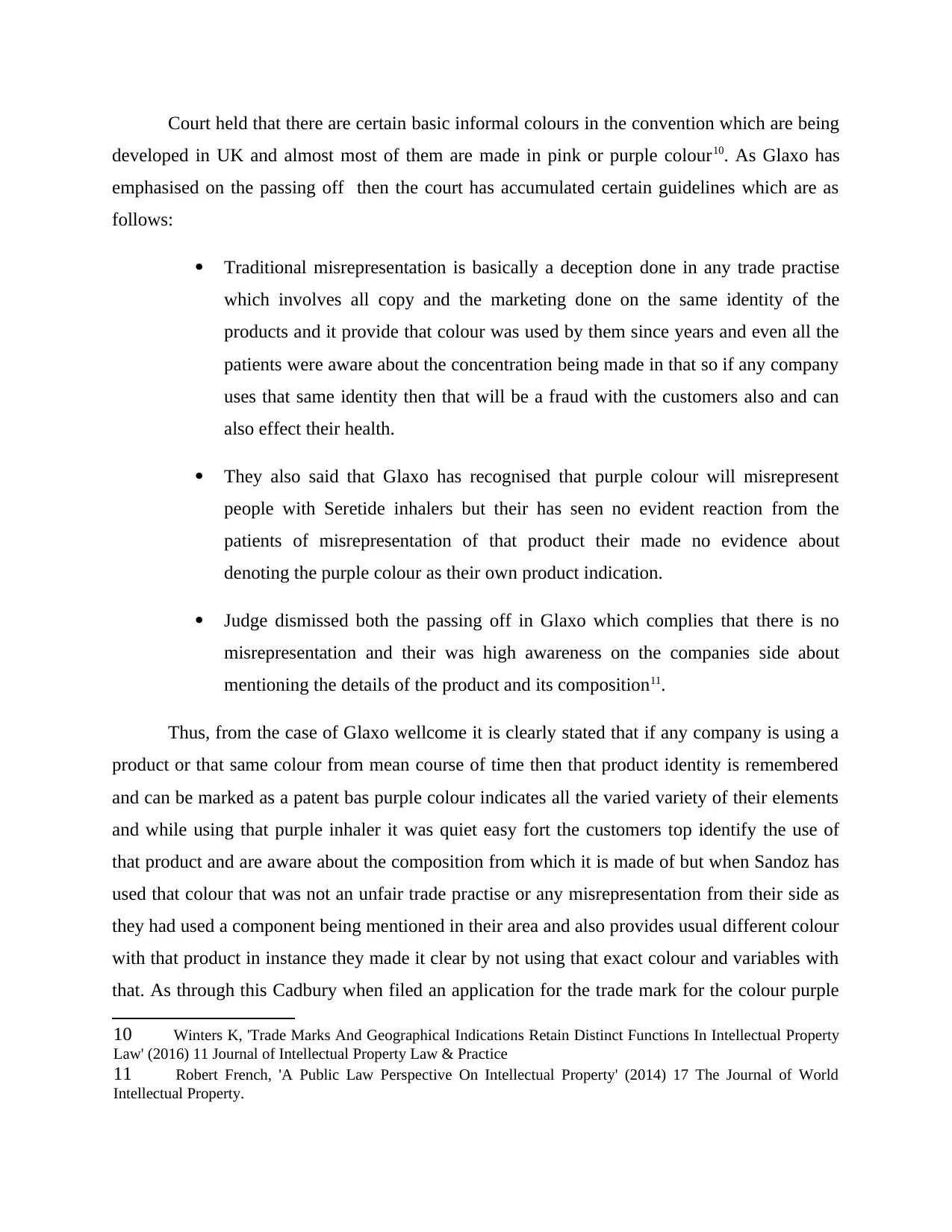
Court held that there are certain basic informal colours in the convention which are being
developed in UK and almost most of them are made in pink or purple colour10. As Glaxo has
emphasised on the passing off then the court has accumulated certain guidelines which are as
follows:
Traditional misrepresentation is basically a deception done in any trade practise
which involves all copy and the marketing done on the same identity of the
products and it provide that colour was used by them since years and even all the
patients were aware about the concentration being made in that so if any company
uses that same identity then that will be a fraud with the customers also and can
also effect their health.
They also said that Glaxo has recognised that purple colour will misrepresent
people with Seretide inhalers but their has seen no evident reaction from the
patients of misrepresentation of that product their made no evidence about
denoting the purple colour as their own product indication.
Judge dismissed both the passing off in Glaxo which complies that there is no
misrepresentation and their was high awareness on the companies side about
mentioning the details of the product and its composition11.
Thus, from the case of Glaxo wellcome it is clearly stated that if any company is using a
product or that same colour from mean course of time then that product identity is remembered
and can be marked as a patent bas purple colour indicates all the varied variety of their elements
and while using that purple inhaler it was quiet easy fort the customers top identify the use of
that product and are aware about the composition from which it is made of but when Sandoz has
used that colour that was not an unfair trade practise or any misrepresentation from their side as
they had used a component being mentioned in their area and also provides usual different colour
with that product in instance they made it clear by not using that exact colour and variables with
that. As through this Cadbury when filed an application for the trade mark for the colour purple
10 Winters K, 'Trade Marks And Geographical Indications Retain Distinct Functions In Intellectual Property
Law' (2016) 11 Journal of Intellectual Property Law & Practice
11 Robert French, 'A Public Law Perspective On Intellectual Property' (2014) 17 The Journal of World
Intellectual Property.
developed in UK and almost most of them are made in pink or purple colour10. As Glaxo has
emphasised on the passing off then the court has accumulated certain guidelines which are as
follows:
Traditional misrepresentation is basically a deception done in any trade practise
which involves all copy and the marketing done on the same identity of the
products and it provide that colour was used by them since years and even all the
patients were aware about the concentration being made in that so if any company
uses that same identity then that will be a fraud with the customers also and can
also effect their health.
They also said that Glaxo has recognised that purple colour will misrepresent
people with Seretide inhalers but their has seen no evident reaction from the
patients of misrepresentation of that product their made no evidence about
denoting the purple colour as their own product indication.
Judge dismissed both the passing off in Glaxo which complies that there is no
misrepresentation and their was high awareness on the companies side about
mentioning the details of the product and its composition11.
Thus, from the case of Glaxo wellcome it is clearly stated that if any company is using a
product or that same colour from mean course of time then that product identity is remembered
and can be marked as a patent bas purple colour indicates all the varied variety of their elements
and while using that purple inhaler it was quiet easy fort the customers top identify the use of
that product and are aware about the composition from which it is made of but when Sandoz has
used that colour that was not an unfair trade practise or any misrepresentation from their side as
they had used a component being mentioned in their area and also provides usual different colour
with that product in instance they made it clear by not using that exact colour and variables with
that. As through this Cadbury when filed an application for the trade mark for the colour purple
10 Winters K, 'Trade Marks And Geographical Indications Retain Distinct Functions In Intellectual Property
Law' (2016) 11 Journal of Intellectual Property Law & Practice
11 Robert French, 'A Public Law Perspective On Intellectual Property' (2014) 17 The Journal of World
Intellectual Property.
⊘ This is a preview!⊘
Do you want full access?
Subscribe today to unlock all pages.

Trusted by 1+ million students worldwide
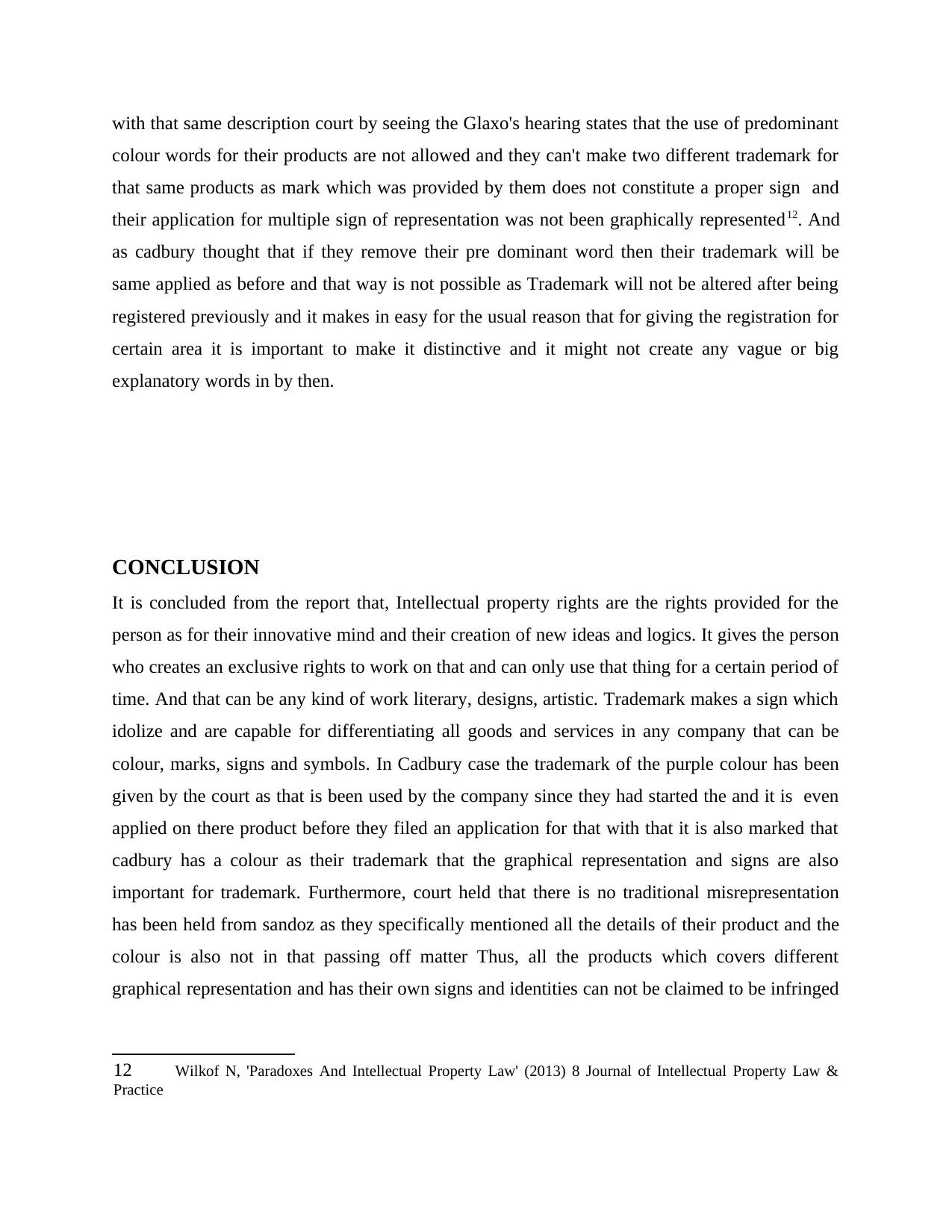
with that same description court by seeing the Glaxo's hearing states that the use of predominant
colour words for their products are not allowed and they can't make two different trademark for
that same products as mark which was provided by them does not constitute a proper sign and
their application for multiple sign of representation was not been graphically represented12. And
as cadbury thought that if they remove their pre dominant word then their trademark will be
same applied as before and that way is not possible as Trademark will not be altered after being
registered previously and it makes in easy for the usual reason that for giving the registration for
certain area it is important to make it distinctive and it might not create any vague or big
explanatory words in by then.
CONCLUSION
It is concluded from the report that, Intellectual property rights are the rights provided for the
person as for their innovative mind and their creation of new ideas and logics. It gives the person
who creates an exclusive rights to work on that and can only use that thing for a certain period of
time. And that can be any kind of work literary, designs, artistic. Trademark makes a sign which
idolize and are capable for differentiating all goods and services in any company that can be
colour, marks, signs and symbols. In Cadbury case the trademark of the purple colour has been
given by the court as that is been used by the company since they had started the and it is even
applied on there product before they filed an application for that with that it is also marked that
cadbury has a colour as their trademark that the graphical representation and signs are also
important for trademark. Furthermore, court held that there is no traditional misrepresentation
has been held from sandoz as they specifically mentioned all the details of their product and the
colour is also not in that passing off matter Thus, all the products which covers different
graphical representation and has their own signs and identities can not be claimed to be infringed
12 Wilkof N, 'Paradoxes And Intellectual Property Law' (2013) 8 Journal of Intellectual Property Law &
Practice
colour words for their products are not allowed and they can't make two different trademark for
that same products as mark which was provided by them does not constitute a proper sign and
their application for multiple sign of representation was not been graphically represented12. And
as cadbury thought that if they remove their pre dominant word then their trademark will be
same applied as before and that way is not possible as Trademark will not be altered after being
registered previously and it makes in easy for the usual reason that for giving the registration for
certain area it is important to make it distinctive and it might not create any vague or big
explanatory words in by then.
CONCLUSION
It is concluded from the report that, Intellectual property rights are the rights provided for the
person as for their innovative mind and their creation of new ideas and logics. It gives the person
who creates an exclusive rights to work on that and can only use that thing for a certain period of
time. And that can be any kind of work literary, designs, artistic. Trademark makes a sign which
idolize and are capable for differentiating all goods and services in any company that can be
colour, marks, signs and symbols. In Cadbury case the trademark of the purple colour has been
given by the court as that is been used by the company since they had started the and it is even
applied on there product before they filed an application for that with that it is also marked that
cadbury has a colour as their trademark that the graphical representation and signs are also
important for trademark. Furthermore, court held that there is no traditional misrepresentation
has been held from sandoz as they specifically mentioned all the details of their product and the
colour is also not in that passing off matter Thus, all the products which covers different
graphical representation and has their own signs and identities can not be claimed to be infringed
12 Wilkof N, 'Paradoxes And Intellectual Property Law' (2013) 8 Journal of Intellectual Property Law &
Practice
Paraphrase This Document
Need a fresh take? Get an instant paraphrase of this document with our AI Paraphraser

or copied and it is important to keep that in mind that intellectual property right is an important
element in all source of business for making their identity and creation as for benefit.
element in all source of business for making their identity and creation as for benefit.
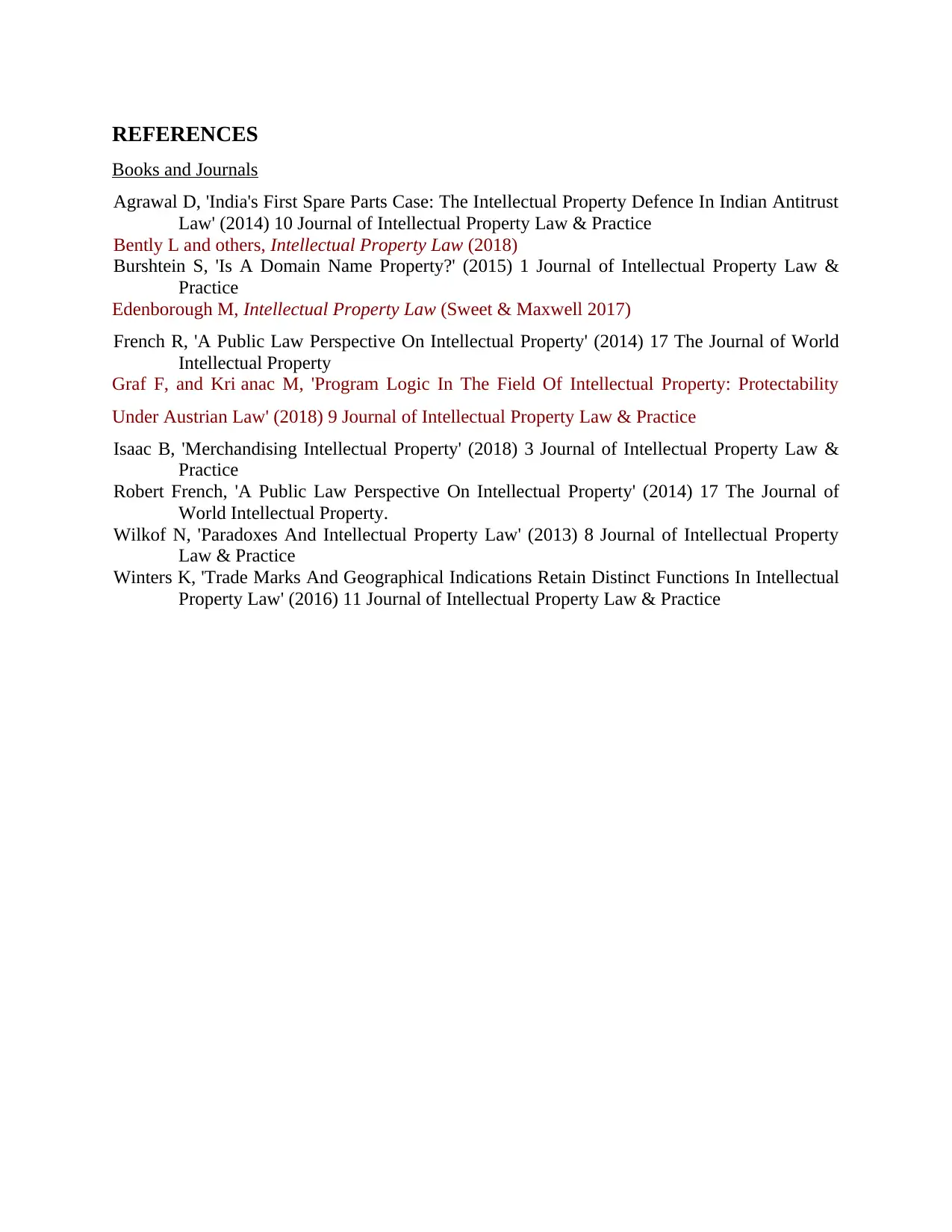
REFERENCES
Books and Journals
Agrawal D, 'India's First Spare Parts Case: The Intellectual Property Defence In Indian Antitrust
Law' (2014) 10 Journal of Intellectual Property Law & Practice
Bently L and others, Intellectual Property Law (2018)
Burshtein S, 'Is A Domain Name Property?' (2015) 1 Journal of Intellectual Property Law &
Practice
Edenborough M, Intellectual Property Law (Sweet & Maxwell 2017)
French R, 'A Public Law Perspective On Intellectual Property' (2014) 17 The Journal of World
Intellectual Property
Graf F, and Kri anac M, 'Program Logic In The Field Of Intellectual Property: Protectability
Under Austrian Law' (2018) 9 Journal of Intellectual Property Law & Practice
Isaac B, 'Merchandising Intellectual Property' (2018) 3 Journal of Intellectual Property Law &
Practice
Robert French, 'A Public Law Perspective On Intellectual Property' (2014) 17 The Journal of
World Intellectual Property.
Wilkof N, 'Paradoxes And Intellectual Property Law' (2013) 8 Journal of Intellectual Property
Law & Practice
Winters K, 'Trade Marks And Geographical Indications Retain Distinct Functions In Intellectual
Property Law' (2016) 11 Journal of Intellectual Property Law & Practice
Books and Journals
Agrawal D, 'India's First Spare Parts Case: The Intellectual Property Defence In Indian Antitrust
Law' (2014) 10 Journal of Intellectual Property Law & Practice
Bently L and others, Intellectual Property Law (2018)
Burshtein S, 'Is A Domain Name Property?' (2015) 1 Journal of Intellectual Property Law &
Practice
Edenborough M, Intellectual Property Law (Sweet & Maxwell 2017)
French R, 'A Public Law Perspective On Intellectual Property' (2014) 17 The Journal of World
Intellectual Property
Graf F, and Kri anac M, 'Program Logic In The Field Of Intellectual Property: Protectability
Under Austrian Law' (2018) 9 Journal of Intellectual Property Law & Practice
Isaac B, 'Merchandising Intellectual Property' (2018) 3 Journal of Intellectual Property Law &
Practice
Robert French, 'A Public Law Perspective On Intellectual Property' (2014) 17 The Journal of
World Intellectual Property.
Wilkof N, 'Paradoxes And Intellectual Property Law' (2013) 8 Journal of Intellectual Property
Law & Practice
Winters K, 'Trade Marks And Geographical Indications Retain Distinct Functions In Intellectual
Property Law' (2016) 11 Journal of Intellectual Property Law & Practice
⊘ This is a preview!⊘
Do you want full access?
Subscribe today to unlock all pages.

Trusted by 1+ million students worldwide
1 out of 9
Your All-in-One AI-Powered Toolkit for Academic Success.
+13062052269
info@desklib.com
Available 24*7 on WhatsApp / Email
![[object Object]](/_next/static/media/star-bottom.7253800d.svg)
Unlock your academic potential
Copyright © 2020–2025 A2Z Services. All Rights Reserved. Developed and managed by ZUCOL.


